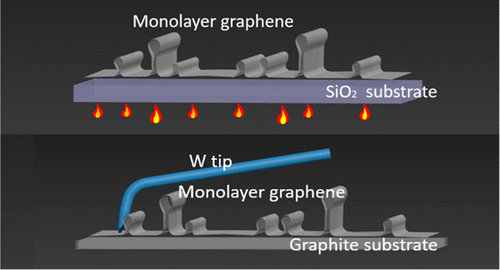Our official English website, www.x-mol.net, welcomes your
feedback! (Note: you will need to create a separate account there.)
Critical Stable Length in Wrinkles of Two-Dimensional Materials.
ACS Nano ( IF 15.8 ) Pub Date : 2020-02-03 , DOI: 10.1021/acsnano.9b08928 Fangyuan Zheng 1, 2 , Quoc Huy Thi 3, 4 , Lok Wing Wong 1, 2 , Qingming Deng 5 , Thuc Hue Ly 3, 4 , Jiong Zhao 1, 2
ACS Nano ( IF 15.8 ) Pub Date : 2020-02-03 , DOI: 10.1021/acsnano.9b08928 Fangyuan Zheng 1, 2 , Quoc Huy Thi 3, 4 , Lok Wing Wong 1, 2 , Qingming Deng 5 , Thuc Hue Ly 3, 4 , Jiong Zhao 1, 2
Affiliation

|
The emergent two-dimensional (2D) materials are atomically thin and ultraflexible, promising for a variety of miniaturized, high-performance, and flexible devices in applications. On one hand, the ultrahigh flexibility causes problems: the prevalent wrinkles in 2D materials may undermine the ideal properties and create barriers in fabrication, processing, and quality control of materials. On the other hand, in some cases the wrinkles are used for the architecturing of surface texture and the modulation of physical/chemical properties. Therefore, a thorough understanding of the mechanism and stability of wrinkles is highly needed. Herein, we report a critical length for stabilizing the wrinkles in 2D materials, observed in the wrinkling and wrinkle elimination processes upon thermal annealing as well as by our in situ TEM manipulations on individual wrinkles, which directly capture the evolving wrinkles with variable lengths. The experiments, mechanical modeling, and self-consistent charge density functional tight binding (SCC-DFTB) simulations reveal that a minimum critical length is required for stabilizing the wrinkles in 2D materials. Wrinkles with lengths below a critical value are unstable and removable by thermal annealing, while wrinkles with lengths above a critical value are self-stabilized by van der Waals interactions. It additionally confirms the pronounced frictional effects in wrinkles with lengths above critical value during dynamical movement or sliding.
中文翻译:

二维材料皱纹中的临界稳定长度。
新兴的二维(2D)材料原子薄且具有超柔韧性,有望在应用中用于各种小型化,高性能和柔性设备。一方面,超高柔韧性会带来问题:二维材料中普遍存在的皱纹可能会破坏理想的性能,并在材料的制造,加工和质量控制中造成障碍。另一方面,在某些情况下,皱纹用于构造表面纹理和调节物理/化学性质。因此,非常需要对皱纹的机理和稳定性有透彻的了解。在此,我们报告了稳定二维材料皱纹的临界长度,在热退火以及通过我们对单个皱纹的原位TEM处理中起皱和消除皱纹的过程中观察到,这些皱纹直接捕获了长度可变的不断发展的皱纹。实验,机械建模和自洽电荷密度功能紧密结合(SCC-DFTB)模拟表明,需要最小的临界长度来稳定2D材料中的皱纹。长度低于临界值的皱纹是不稳定的,可以通过热退火去除,而长度高于临界值的皱纹则可以通过范德华相互作用进行自我稳定。它进一步证实了在动态运动或滑动过程中,长度超过临界值的皱纹具有明显的摩擦效果。实验,机械建模和自洽电荷密度功能紧密结合(SCC-DFTB)模拟表明,需要最小的临界长度来稳定2D材料中的皱纹。长度低于临界值的皱纹是不稳定的,可以通过热退火去除,而长度高于临界值的皱纹则可以通过范德华相互作用进行自我稳定。它进一步证实了在动态运动或滑动过程中,长度超过临界值的皱纹具有明显的摩擦效果。实验,机械建模和自洽电荷密度功能紧密结合(SCC-DFTB)模拟表明,需要最小的临界长度来稳定2D材料中的皱纹。长度低于临界值的皱纹是不稳定的,可以通过热退火去除,而长度高于临界值的皱纹则可以通过范德华相互作用进行自我稳定。它进一步证实了在动态运动或滑动过程中,长度超过临界值的皱纹具有明显的摩擦效果。而长度超过临界值的皱纹则通过范德华相互作用而自我稳定。它进一步证实了在动态运动或滑动过程中,长度超过临界值的皱纹具有明显的摩擦效果。而长度超过临界值的皱纹则通过范德华相互作用而自我稳定。它进一步证实了在动态运动或滑动过程中,长度超过临界值的皱纹具有明显的摩擦效果。
更新日期:2020-02-03
中文翻译:

二维材料皱纹中的临界稳定长度。
新兴的二维(2D)材料原子薄且具有超柔韧性,有望在应用中用于各种小型化,高性能和柔性设备。一方面,超高柔韧性会带来问题:二维材料中普遍存在的皱纹可能会破坏理想的性能,并在材料的制造,加工和质量控制中造成障碍。另一方面,在某些情况下,皱纹用于构造表面纹理和调节物理/化学性质。因此,非常需要对皱纹的机理和稳定性有透彻的了解。在此,我们报告了稳定二维材料皱纹的临界长度,在热退火以及通过我们对单个皱纹的原位TEM处理中起皱和消除皱纹的过程中观察到,这些皱纹直接捕获了长度可变的不断发展的皱纹。实验,机械建模和自洽电荷密度功能紧密结合(SCC-DFTB)模拟表明,需要最小的临界长度来稳定2D材料中的皱纹。长度低于临界值的皱纹是不稳定的,可以通过热退火去除,而长度高于临界值的皱纹则可以通过范德华相互作用进行自我稳定。它进一步证实了在动态运动或滑动过程中,长度超过临界值的皱纹具有明显的摩擦效果。实验,机械建模和自洽电荷密度功能紧密结合(SCC-DFTB)模拟表明,需要最小的临界长度来稳定2D材料中的皱纹。长度低于临界值的皱纹是不稳定的,可以通过热退火去除,而长度高于临界值的皱纹则可以通过范德华相互作用进行自我稳定。它进一步证实了在动态运动或滑动过程中,长度超过临界值的皱纹具有明显的摩擦效果。实验,机械建模和自洽电荷密度功能紧密结合(SCC-DFTB)模拟表明,需要最小的临界长度来稳定2D材料中的皱纹。长度低于临界值的皱纹是不稳定的,可以通过热退火去除,而长度高于临界值的皱纹则可以通过范德华相互作用进行自我稳定。它进一步证实了在动态运动或滑动过程中,长度超过临界值的皱纹具有明显的摩擦效果。而长度超过临界值的皱纹则通过范德华相互作用而自我稳定。它进一步证实了在动态运动或滑动过程中,长度超过临界值的皱纹具有明显的摩擦效果。而长度超过临界值的皱纹则通过范德华相互作用而自我稳定。它进一步证实了在动态运动或滑动过程中,长度超过临界值的皱纹具有明显的摩擦效果。











































 京公网安备 11010802027423号
京公网安备 11010802027423号